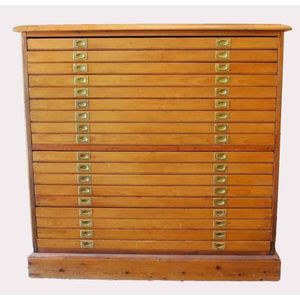Pine Wellington Specimen Chests with 15 Drawers
You must be a subscriber, and be logged in to view price and dealer details.
Subscribe Now to view actual auction price for this item
When you subscribe, you have the option of setting the currency in which to display prices to $Au, $US, $NZ or Stg.
- Pilasters - In furniture a pilaster is a flattened column-like detail
applied to furniture. It is similar to a pilaster in architecture, but it is
typically smaller and less ornate. Pilasters are often used to decorate the
fronts of bookcases, cabinets, and other pieces of furniture. Pilasters can be
made of wood, metal, or other materials. They can be fluted, carved, or plain.
Pilasters are often used to add a touch of elegance and sophistication to
furniture. - Turning - Any part of a piece of furniture that has been turned and shaped with chisels on a lathe. Turned sections include legs, columns, feet, finials, pedestals, stretchers, spindles etc. There have been many varieties and fashions over the centuries: baluster, melon, barley-sugar, bobbin, cotton-reel, rope-twist, and so on. Split turning implies a turned section that has been cut in half lengthwise and applied to a cabinet front as a false decorative support.
- Plinth - The square or rectangular base of a piece of cabinet furniture, often ornamented with moulding. The plinth may be separate, as in some wardrobes or presses, and act as the support for the carcase. In a false plinth, the moulded boards may be attached directly to the piece. Furniture with a plinth base usually does not have separate feet. The term derives from architecture where it denotes the base of a column or statue.
- Mounts - Mounts are used to describe bronze, brass and ormolu adornments on furniture especially quality furniture in the rococo and classical revival style, and are also the cabinet makers' name for the metal fittings on furniture, such as hinges, locks and handles, and metal edges and guards which protect furniture from damage.
This item has been included into following indexes:
Visually similar items

A vintage mahogany Wellington chest, seven drawers, raised on plinth base, requires some attention. Width 62 cm, depth 40 cm, height 112 cm.

Tallboy: English country pine six drawer chest on turned bun feet with brass swing handles. Early to mid 19th century. Height 150 cm, width 105 cm, depth 54 cm

Twenty-five bound volumes of 'The journal of the Orders and Medals Research Society'. London : Printed by Grillford Limited, 1973-97. 8vo. Illustrated. Maroon cloth bindings with title to spines. Contents clean. A superb resource. Includes a separate volum

Oregon pine plan cabinet, c.1900, with 18 drawers, brass handles. Height 147 cm. Width 151 cm; 87.5 cm. Provenance: Greenhill Gallery
